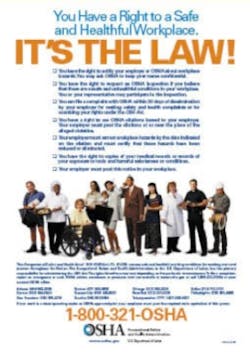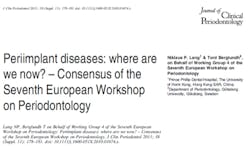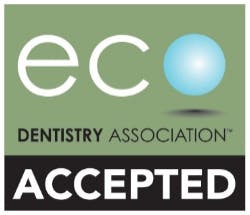Toxins in the dental office: Are they making you sick?
April 19, 2012
By Maria Perno Goldie, RDH, MS
Employers are responsible for providing a safe and healthful workplace for their employees. The Occupational Safety and Health Administration’s (OSHA’s) role is to assure the safety and health of America’s employees by: setting and enforcing standards; providing training, outreach and education; establishing partnerships; and encouraging continual improvement in workplace safety and health. For more information on OSHA and the dental office, in the areas of bloodborne pathogens, hazard communication, ioninzing radiation, posters, reporting, and more, see the OSHA website.(1)
Employers are responsible for providing a safe and healthful workplace for their employees. The Occupational Safety and Health Administration’s (OSHA’s) role is to assure the safety and health of America’s employees by: setting and enforcing standards; providing training, outreach and education; establishing partnerships; and encouraging continual improvement in workplace safety and health. For more information on OSHA and the dental office, in the areas of bloodborne pathogens, hazard communication, ioninzing radiation, posters, reporting, and more, see the OSHA website.(1)
One toxin to be aware of in the office is glutaraldehyde. Glutaraldehyde has been used widely as a cold sterilant to disinfect a variety of heat-sensitive instruments.(2) In addition, health care employees may be exposed to glutaraldehyde in its uses as a hardener in X-ray developing and as a tissue fixative in histology and pathology labs.
Glutaraldehyde
The most serious adverse health effect documented among employees exposed to glutaraldehyde vapor is occupational asthma, a chronic condition characterized by bronchial hyperresponsiveness. Reactions can be either immediate or delayed, with a latent period ranging from a few weeks to several years from the onset of exposure.(3) Now, instead of using this chemical, we can (and should) use an autoclave or other heat sterilization alternatives. Check the on-line product guide from the Eco-Dentistry Association for information on surface disinfectants that will ensure proper infection control without harming the health of health care workers.(4) Asthma is a chronic lung disease that affects people of all ages. It causes episodes of wheezing, coughing, shortness of breath, and chest tightness. Although there is no cure, most people with asthma are able to manage the disease with medications and behavioral changes. Researchers also are studying various complementary health approaches for asthma relief. Read the recent issue of the National Center for Complementary and Alternative Medicine (NCCAM) newsletter, which provides information on “what the science says” about complementary health practices for asthma, including acupuncture, breathing exercises, and herbs and other dietary supplements.(5) Who would have thought … bib holders! Researchers at the University of Witten/Herdecke in North Rhine-Westphalia, Germany, released a clinical study that indicates the sterilization protocol for dental bib holders is inconsistent, and can result in the presence of microorganisms on bib chains and holders.(6) This is consistent with previously published studies. The study examined a total of 30 metal and plastic bib holders and found bacteria present on more than half of them. Seventy percent of all reusable bib holders were contaminated with microbes. The predominant colony types identified were staphylococci and streptococci, along with various bacterial rods, pseudomonas, fungi and other types of cocci. Although the bacteria found in this study were all nonpathogenic bacteria, in principle reusable bib holders can cross contaminate dental patients. The bacteria found on the bib holders can be a threat to immune-suppressed patients, and young children and the elderly who also often have compromised immune systems. Bacteria from an unsterilized bib holder can enter the body when a patient touches the bib holder or their neck after a dental visit, and then rubs an eye or touches their mouth. Cross-contamination can also occur: when a bib chain is splattered with saliva, plaque, blood, and spray from the mouth; when a bib chain catches onto hair and accumulate with the wearer’s sweat, make-up, and neck acne; and if the dental worker applies a dirty bib chain with their gloved hands before the examination or cleaning. An alternative is to use disposable bib holders, such as those available through Dux Dental.(7)
The most serious adverse health effect documented among employees exposed to glutaraldehyde vapor is occupational asthma, a chronic condition characterized by bronchial hyperresponsiveness. Reactions can be either immediate or delayed, with a latent period ranging from a few weeks to several years from the onset of exposure.(3) Now, instead of using this chemical, we can (and should) use an autoclave or other heat sterilization alternatives. Check the on-line product guide from the Eco-Dentistry Association for information on surface disinfectants that will ensure proper infection control without harming the health of health care workers.(4) Asthma is a chronic lung disease that affects people of all ages. It causes episodes of wheezing, coughing, shortness of breath, and chest tightness. Although there is no cure, most people with asthma are able to manage the disease with medications and behavioral changes. Researchers also are studying various complementary health approaches for asthma relief. Read the recent issue of the National Center for Complementary and Alternative Medicine (NCCAM) newsletter, which provides information on “what the science says” about complementary health practices for asthma, including acupuncture, breathing exercises, and herbs and other dietary supplements.(5) Who would have thought … bib holders! Researchers at the University of Witten/Herdecke in North Rhine-Westphalia, Germany, released a clinical study that indicates the sterilization protocol for dental bib holders is inconsistent, and can result in the presence of microorganisms on bib chains and holders.(6) This is consistent with previously published studies. The study examined a total of 30 metal and plastic bib holders and found bacteria present on more than half of them. Seventy percent of all reusable bib holders were contaminated with microbes. The predominant colony types identified were staphylococci and streptococci, along with various bacterial rods, pseudomonas, fungi and other types of cocci. Although the bacteria found in this study were all nonpathogenic bacteria, in principle reusable bib holders can cross contaminate dental patients. The bacteria found on the bib holders can be a threat to immune-suppressed patients, and young children and the elderly who also often have compromised immune systems. Bacteria from an unsterilized bib holder can enter the body when a patient touches the bib holder or their neck after a dental visit, and then rubs an eye or touches their mouth. Cross-contamination can also occur: when a bib chain is splattered with saliva, plaque, blood, and spray from the mouth; when a bib chain catches onto hair and accumulate with the wearer’s sweat, make-up, and neck acne; and if the dental worker applies a dirty bib chain with their gloved hands before the examination or cleaning. An alternative is to use disposable bib holders, such as those available through Dux Dental.(7)
A recent article warns of risk of bacterial growth in compressed air receivers. [Djurhuus, D. Focus on hygiene in dental compressors.](8) The author states: “Bacteria blown directly into an open wound are of course hazardous to your health--ordinary bacteria might be acceptable but when dealing with enterobacteria, salmonella, listeria, coli, etc., the effects are much more serious. It is, therefore, important that steps should be taken to avoid accumulation of condensate in the compressed air tank of the compressor.” The article continues with information on the importance of air intake, the danger of corrosion and maintenance of filters. The author recommends oil-less compressors to ensure totally clean air along with adsorption air dryers with filters. He lists three conditions to ensure good and clean compressed air: correctly sized oil-less compressor with adsorption air dryer and filters; must be placed where the air taken in is clean, i.e., free of basic substances, and cool; and daily maintenance to be carried out in accordance with the manufacturer’s directions. For a sampling of oil-less compressors, visit the DentalEZ and Kaeser web sites for information.(9) Another issue we deal with is infected dentures. Organisms such as methicillin-resistant Staphylococcus aureus (MRSA) biofilm on dentures can be aspirated, thus causing infections such as aspiration pneumonia. A recently published study evaluated the efficacy of two disinfectant solutions and microwave irradiation in disinfecting complete dentures contaminated with MRSA.(10) They found that soaking dentures in chlorhexidine gluconate solution and microwave irradiation resulted in complete disinfection of all dentures contaminated with MRSA in both the short and the long term. Soaking in sodium hypochlorite solution was effective only as a short-term disinfectant. Microwave irradiation and 2 percent chlorhexidine gluconate may have a disinfective application in dental offices and institutions in which denture wearers are treated, thus improving the longevity and quality of life of patients and reducing the burden of disease caused by MRSA.
The EDA Accepted Seal is the standard for dental products making eco-friendly claims. Companies submit a comprehensive application listing ingredients and purported environmental benefits. The EDA then evaluates and analyzes the manufacturing processes, ingredients, packaging, and other features to determine if the product meets the EDA Accepted standards of outstanding environmental performance. EDA Accepted products are not only safer for the planet, but for practitioners who work with these products every day.(11) In conclusion, as we attempt to keep our patients safe from harm and healthy, we must also be aware that certain products could be making us sick. Beware of toxins in the office, and strive to use safe and “green” alternatives.References
1. Medical & Dental Offices. A Guide to Compliance with OSHA Standards. OSHA 3187-09R, 2003. www.osha.gov/Publications/OSHA3187/osha3187.html. 2. Best Practices for the Safe Use of Glutaraldehyde in Health Care, OSHA 3258-08N, 2006.3. Di Stefano, F., Siriruttanapruk, S., McCoach, J. and P. Sherwood Burge. 1999. Glutaraldehyde: an occupational hazard in the hospital setting. Allergy 54:1105-1109.4. www.ecodentistry.org/.5. nccam.nih.gov/health/providers/digest/asthma-science. 6. www.dentistryiq.com/index/display/article-display/0793083579/articles/dentisryiq/industry/2012/3/german-study.html.7. www.duxdental.com/our_products/infection_control/ic_bibholders.htm#. 8. www.jun-air.com/support_documents/FinnDjurhusArticleEnglish.pdf. 9. www.dentalez.com/customair/, www.kaeser-dental.com/us/products/default.asp.10. Altieri KT, Sanitá PV, Machado AL, Giampaolo ET, Pavarina AC, and Vergani CE. Effectiveness of two disinfectant solutions and microwave irradiation in disinfecting complete dentures contaminated with methicillin-resistant Staphylococcus aureus. JADA 2012;143(3):270-277.11. www.ecodentistry.org/.
1. Medical & Dental Offices. A Guide to Compliance with OSHA Standards. OSHA 3187-09R, 2003. www.osha.gov/Publications/OSHA3187/osha3187.html. 2. Best Practices for the Safe Use of Glutaraldehyde in Health Care, OSHA 3258-08N, 2006.3. Di Stefano, F., Siriruttanapruk, S., McCoach, J. and P. Sherwood Burge. 1999. Glutaraldehyde: an occupational hazard in the hospital setting. Allergy 54:1105-1109.4. www.ecodentistry.org/.5. nccam.nih.gov/health/providers/digest/asthma-science. 6. www.dentistryiq.com/index/display/article-display/0793083579/articles/dentisryiq/industry/2012/3/german-study.html.7. www.duxdental.com/our_products/infection_control/ic_bibholders.htm#. 8. www.jun-air.com/support_documents/FinnDjurhusArticleEnglish.pdf. 9. www.dentalez.com/customair/, www.kaeser-dental.com/us/products/default.asp.10. Altieri KT, Sanitá PV, Machado AL, Giampaolo ET, Pavarina AC, and Vergani CE. Effectiveness of two disinfectant solutions and microwave irradiation in disinfecting complete dentures contaminated with methicillin-resistant Staphylococcus aureus. JADA 2012;143(3):270-277.11. www.ecodentistry.org/.
Maria Perno Goldie, RDH, MS
To read previous articles in RDH eVillage FOCUS written by Maria Perno Goldie, go to articles.











